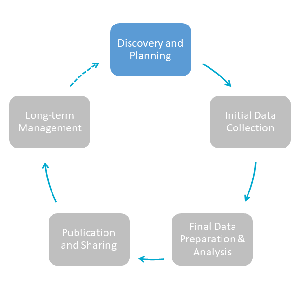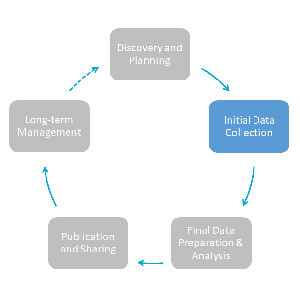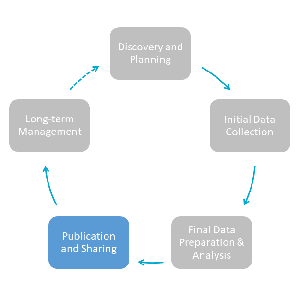Planning for Sharing Human Participant Data
In this lesson you will learn
- Basic outlines of informed consent language
- The potential interactions between securing informed consent from research participants and sharing data generated through interacting with them.
- What to do if you have used informed consent language that precludes sharing but wish to share the data generated through your human participant research
Initial questions
- You may have already created an informed consent script. If so, did you think about how what it said might affect your ability to share the data from your human participant research?
- If you wrote both a DMP and an IRB application, did you think about the overlap between the information included in each and make sure you described your data and your plans for collecting them and managing them the same way?
Institutional Review Boards (IRBs)
Institutional Review Boards (IRBs) (or, more broadly, “ethics boards”) are administrative bodies that govern human participant research in the United States. IRBs protect the rights and welfare of the people whom scholars recruit to participate in their research. Prior to initiating human participant research, scholars must submit an application to conduct the research to the IRB at their home institution. IRBs review applications to ensure that human participants are sufficiently protected. IRBs can approve, disapprove, monitor, and require modifications to all research activities that fall within their jurisdiction, with the overall goal of supervising compliance with federal ethics rules by the institution with which they are affiliated.
IRBs carry out a critically important role. However, ultimately they provide only a minimum legal threshold for ethical research. Conducting human participant research ethically entails much more than what scholars describe in their IRB applications. Moreover, the appropriate role for IRBs in social science research remains a topic of discussion. A recent revision of the Common Rule, the federal regulation governing IRBs in the US, actually removed a significant number of social science research practices, such as oral history, from the purview of IRBs. You should familiarize yourself with the practices and deadlines of your IRB from the earliest stages of your research project.
Informed Consent Basics

A critical aspect of an IRB application is a scholar’s plans for securing the “informed consent” of her research participants. Informed consent is at the heart of ethical research with human participants. Whenever you generate data through interacting with people, you need to make sure they consent to being part of your research, and that they are fully informed about and understand what this participation entails. This is an ethical requirement for social science researchers. In the US, it is also a legal requirement, mandated by guidelines from the federal government. This course does not replace a course about ethical research practices. In the US, you will typically be required to take such a course prior to conducting research with human participants. Our focus in this lesson is on developing and using an informed consent script that does not unnecessarily prevent you from sharing the data produced through your interactions with the people who participate in your research.
A typical informed consent script includes four main elements:
Basic information about the study you are conducting
Any risks and benefits associated with participating in the study
Information about you (the researcher) and your institution, with contact information for both
What participating in the study entails
Commonly, 1-3 are included on a separate study information sheet that participants can take home.
Did you know?
You will often see research participants referred to as “human subjects,” which is how US federal law refers to them. At QDR, we follow the American Psychological Association’s lead and use the terms “research participants” or “human participants” to refer to people a researcher involves in her work to highlight their willing participation and active contribution to the research.
Informed Consent in Qualitative Research

Informed consent procedures derived from laboratory research (e.g., in the medical sciences) are often inappropriate for use in qualitative social science research. One of the advantages of such research is that it often takes place in a setting close to participants’ everyday life, offering the researcher insights beyond what the participant says, and allowing the participant to be at ease. Introducing a legal document to sign in such a context can significantly disrupt your research. But precisely because qualitative research may not seem like research to your participants, informed consent is particularly important.
One way to make the consent process more natural – particularly in contexts where there is a weaker tradition of securing informed consent” – is to secure participants’ consent orally (i.e., use an “oral consent” procedure). Instead of having participants sign a sheet outlining points 1-4 above to offer consent (“written consent”), you verbally run through a script and ask participants to agree with it. One disadvantage of oral consent can be that it leaves you without proof of consent. Where you record interviews, it is common to re-request the consent of your participate (in a highly abbreviated form), and have them verbally agree, at the beginning of the recording.
Scholars are best positioned to obtain truly informed consent – i.e., to clearly communicate to participants what their research is about and what participation entails – in forms of research that allow them to build lasting relationships with participants. No matter in what type of inquiry you engage, however, you should do everything you can to ensure that your research participants understand who you are, the content and aims of your research, what you are asking of them, and what good or bad may come of their participation.
Tip from the field
Oral consent is often – but not always – more appropriate for qualitative research. For instance, one scholar with whom QDR has worked found that her interview respondents (ex-combatants) were reassured by the legitimacy indicated by the written consent form and information sheet. Ask others who have engaged in a similar type of research in the context you are studying about their experiences.
Informed Consent and Data Sharing
The language that scholars employ to secure the informed consent of their research participants has significant implications for their ability to subsequently share the information those participants convey. The language that social science researchers have typically used to secure informed consent precludes data sharing. Two scenarios are common:
The informed consent language specifically states that only the researcher (or the researcher and his team of x collaborators) will have access to the data.
The informed consent specifies that data will be destroyed after a given time
Such restrictions can be appropriate for sensitive, identifiable data, such as audio-recordings of interviews about controversial topics with well-known dissidents. They are almost always in order for the keys that allow you to re-identify subjects from numbers or pseudonyms.
However, when it is ethically possible to do so, you should consider soliciting the informed consent of your research participants not only to participate in your project but also to allow you to share the information they convey to you. While some participants may agree to your sharing that information in a way that identifies them, more commonly you will ask their permission to share the data in de-identified form. You can do so very explicitly.
Consider, for example, this language recently developed by Cornell University’s Institutional Review Board:
“De-identified data from this study may be shared with the research community at large to advance science and health. We will remove or code any personal information that could identify you before files are shared with other researchers.”
Here is another example suggested by ICPSR:
“Any personal information that could identify you will be removed or changed before files are shared with other researchers or results are made public.”
Do not make any promises that you cannot keep. For instance, you can specify that you will remove identifying information, but you should not promise anonymity to participants, as there is no way to guarantee that data are truly anonymous. Also, be sure to keep very careful track of what you have promised to whom.
Safeguarding sensitive information is core to the mission of many data repositories in the social sciences. Accoringly, they can advise you in general terms on de-identification processes, on how to keep information confidential, and on what “access controls” you might place on your data shoud you share them through their repository. We discuss these issues further in Module 3 (Lesson 2).
Exercise
Evaluating Informed Consent Language
Consider these two examples of language from informed consent scripts, identify problems, and suggest improvements.
- Three people will have direct access to these observations: me, and the two other members of the research team. The written observations will be kept during the analysis of the data, that is, about 3 years. After that, they will be destroyed.
- We will anonymize all data before sharing it in a trusted digital repository. No one will be able to identify you from that data.
Careful!
Your IRB application (including your informed consent script), and your DMP (if submitted as part of a grant) contain explicit promises to your institution, your participants, and your funder. You should confirm that your promises are consistent across this documentation. For instance, if you promise in your DMP that you will share your research data, your IRB application should indicate the same, and your informed consent script should be structured to allow this possibility.
Exercise
Craft Your Own Consent Language
- Now spend some time with writing or editing your own consent script. Reassure your participants that their data is safe, but do not preclude the sharing of data. If working in a group, exchange scripts with a partner.
Re-consenting Participants

What can you do if you have already interviewed a set of people, want to share the data that those interviews generated, but used consent language that prevents you from sharing? Sadly, the answer to this question is often “nothing”. However, if you established good rapport with your participants and you are able to get in touch with them with relative ease, it is possible to retroactively ask them to consent to sharing more broadly the information that they provided to you. Note that your consent form has been vetted by your IRB, so you must file an amendment to your IRB application with the updated consent form. If your IRB approves the amendment and you are able to re-contact your participants, keep close notes on who did and who didn’t agree to the updated script and remember that you can only share the data that were provided by those who did.
Further Resources
“CARE Principles of Indigenous Data Governance.” n.d. Global Indigenous Data Alliance. Accessed October 18, 2019. https://www.gida-global.org/care. Research with indigenous groups requires particular attention to ethical considerations and their autonomy. The CARE principles focus on data sharing from research with such communities.
Librett, Mitch, and Dina Perrone. 2010. “Apples and Oranges: Ethnography and the IRB.” Qualitative Research 10 (6): 729–47. https://doi.org/10.1177/1468794110380548.
Musoba, Glenda Droogsma, Stacy A Jacob, and Leslie J Robinson. 2014. “The Institutional Review Board (IRB) and Faculty: Does the IRB Challenge Faculty Professionalism in the Social Sciences?” The Qualitative Report 19 (51): 1–14. https://nsuworks.nova.edu/tqr/vol19/iss51/1.
Schrag, Zachary M. 2017. “A Social Scientist’s Guide to the Final Rule.” Institutional Review Blog (blog). January 19, 2017. http://www.institutionalreviewblog.com/2017/01/a-social-scientists-guide-to-final-rule.html.
A useful overview of the changes to the Common Rule governing human participant research that went in force in early 2019
Stark, Laura J. M. 2012. Behind Closed Doors: IRBs and the Making of Ethical Research. Morality and Society Series. Chicago; London: The University of Chicago Press.
An in-depth look at the history and practice of IRB based on a wealth of archival documents and in-person observation of IRB meetings.